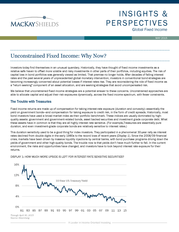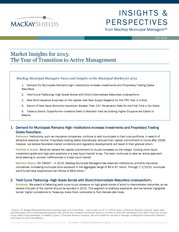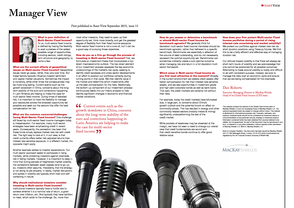Description
INSIGHTS &
PERSPECTIVES
Global Fixed Income
Implementing an Unconstrained Strategy
A “go anywhere” strategy seeks to identify the prevailing risks and return opportunities, whatever the stage of the economic and
market cycles, so as to maximize risk-adjusted returns. This includes having some insurance in place against “tail events”—
those rare but extreme market shocks that result in outsized losses, as happened in 2008/09.
The leaders of our Global Fixed Income team have worked together for more than 20 years. Based on their experience over
several market cycles, they believe the best way to implement an unconstrained strategy is to integrate a rigorous fundamental
bottom-up investment approach with a top-down macroeconomic overlay.
As part of the top-down element of our investment process we analyze the economic underpinnings of the market’s risk cycle.
This takes into account the stages of the economic cycle, and the impact of monetary policy on the capital markets (Display 3,
above). Central bank monetary policy action is the single largest contributor to credit availability and an important driver of the
inflection points in the market cycle.
Our macroeconomic analysis enables us to identify credit excesses and cross sector developments more clearly, allowing us to reposition our portfolios in anticipation of cyclical turning points. The bottom-up component of our investment process continuously feeds into the macro analysis to help identify significant changes in financial market conditions, economic developments and areas of credit excess. Thus, the primary sources of value added (and overall portfolio performance) are asset allocation across credit sectors, and security selection within those sectors. Our approach seeks to preserve capital by allocating to non-credit sectors (for example Treasuries or agency mortgages) during defensive periods and for liquidity purposes. Consistent with this approach, duration management is focused on downside protection and capital preservation. Maneuverability is also important to flexible investment approaches, and in this respect we’d argue that smaller funds have a potential advantage.
Large volumes of money have been put to work in the “non-traditional” space in recent years (according to Morningstar that bond category received inflows of more than $76 billion in the two years from 2013 to 2014) and fund sizes are growing. Against this backdrop, we think the largest funds may not be as nimble as before, for example when liquidating positions and switching into new exposures. In Summary… In today’s environment, investors can’t afford to be passive about interest-rate risk. The fall in yields that made the traditional benchmark approach successful for 30 years is now in its late stages.
The unprecedented liquidity pumped into the markets by central banks in response to the credit crisis has kept interest rates extraordinarily low, but sooner or later they are likely to rise. From now on, managers will have to choose their exposures more carefully, and they need the freedom to express their best research ideas across a broad spectrum of fixed income sectors. For many types of investor we therefore believe that an unconstrained strategy can play a powerful role as an extension of traditional bond management. This material contains the opinions of the Global Fixed Income team of MacKay Shields LLC but not necessarily those of MacKay Shields LLC. The opinions expressed herein are subject to change without notice.
This material is distributed for informational purposes only. Forecasts, estimates, and opinions contained herein should not be considered as investment advice or a recommendation of any particular security, strategy or investment product. Information contained herein has been obtained from sources believed to be reliable, but not guaranteed.
No part of this document may be reproduced in any form, or referred to in any other publication, without express written permission of MacKay Shields LLC. ©2015, MacKay Shields LLC. Note to European Readers: This document has been issued by MacKay Shields UK LLP, 200 Aldersgate Street, London, EC1A 4HD which is authorised and regulated by the UK Financial Conduct Authority (FRN594166). A Leader in Income-Oriented Investing 4 .
Our macroeconomic analysis enables us to identify credit excesses and cross sector developments more clearly, allowing us to reposition our portfolios in anticipation of cyclical turning points. The bottom-up component of our investment process continuously feeds into the macro analysis to help identify significant changes in financial market conditions, economic developments and areas of credit excess. Thus, the primary sources of value added (and overall portfolio performance) are asset allocation across credit sectors, and security selection within those sectors. Our approach seeks to preserve capital by allocating to non-credit sectors (for example Treasuries or agency mortgages) during defensive periods and for liquidity purposes. Consistent with this approach, duration management is focused on downside protection and capital preservation. Maneuverability is also important to flexible investment approaches, and in this respect we’d argue that smaller funds have a potential advantage.
Large volumes of money have been put to work in the “non-traditional” space in recent years (according to Morningstar that bond category received inflows of more than $76 billion in the two years from 2013 to 2014) and fund sizes are growing. Against this backdrop, we think the largest funds may not be as nimble as before, for example when liquidating positions and switching into new exposures. In Summary… In today’s environment, investors can’t afford to be passive about interest-rate risk. The fall in yields that made the traditional benchmark approach successful for 30 years is now in its late stages.
The unprecedented liquidity pumped into the markets by central banks in response to the credit crisis has kept interest rates extraordinarily low, but sooner or later they are likely to rise. From now on, managers will have to choose their exposures more carefully, and they need the freedom to express their best research ideas across a broad spectrum of fixed income sectors. For many types of investor we therefore believe that an unconstrained strategy can play a powerful role as an extension of traditional bond management. This material contains the opinions of the Global Fixed Income team of MacKay Shields LLC but not necessarily those of MacKay Shields LLC. The opinions expressed herein are subject to change without notice.
This material is distributed for informational purposes only. Forecasts, estimates, and opinions contained herein should not be considered as investment advice or a recommendation of any particular security, strategy or investment product. Information contained herein has been obtained from sources believed to be reliable, but not guaranteed.
No part of this document may be reproduced in any form, or referred to in any other publication, without express written permission of MacKay Shields LLC. ©2015, MacKay Shields LLC. Note to European Readers: This document has been issued by MacKay Shields UK LLP, 200 Aldersgate Street, London, EC1A 4HD which is authorised and regulated by the UK Financial Conduct Authority (FRN594166). A Leader in Income-Oriented Investing 4 .









